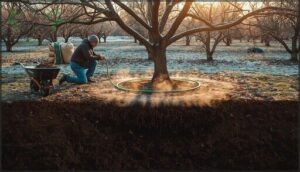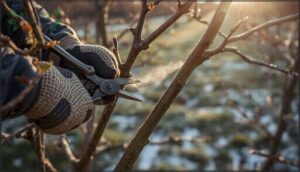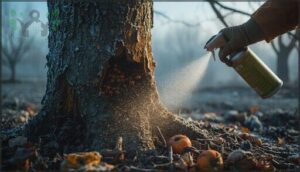This site is supported by our readers. We may earn a commission, at no cost to you, if you purchase through links.

Your fruit trees don’t stop needing attention just because the snow starts falling. In fact, the dormant season presents some of the biggest threats to your orchard’s survival—frozen roots can kill a young tree faster than any summer pest, and bark splitting from temperature swings ruins years of growth in a single night. Most orchardists focus entirely on spring and summer care, then watch their trees struggle or die because they skipped essential winter protection.
Caring for fruit trees in winter means understanding that dormancy isn’t hibernation—your trees are still vulnerable to wind damage, pest infestations, and moisture stress even when they look lifeless. The good news is that a few strategic steps taken before and during the cold months will protect your investment and set up a productive harvest next season.
Table Of Contents
Key Takeaways
- Dormant fruit trees remain vulnerable to frozen roots, bark splitting from temperature swings, and pest infestations even when they appear lifeless, making winter protection essential for survival and next season’s harvest.
- Deep watering before ground freeze (10 gallons per trunk diameter inch), proper mulching extending to the drip line, and trunk wrapping prevent the most common winter damage that kills young trees and ruins years of growth.
- Removing fruit mummies and debris cuts disease inoculum by 80%, while dormant oil sprays applied in late winter reduce spring pest populations by over 60% when temperatures hold between 40°F and 70°F.
- Monthly winter inspections catch problems early, allowing you to adjust mulch depth, monitor for rodent damage, and track chilling hours needed for proper spring bud break and fruit production.
Identifying Fruit Tree Types for Winter Care
Not all fruit trees face winter the same way. Some drop their leaves and go dormant, while others keep their foliage and stay active through the cold months.
Understanding which type you’re working with helps you choose the right protection methods and avoid common mistakes.
Deciduous Vs. Evergreen Fruit Trees
When winter arrives, your fruit trees respond differently based on evolutionary adaptations. Deciduous trees like apples and cherries protect themselves through leaf shedding, entering deep dormancy to survive harsh cold. Evergreen citrus and figs keep their leaves year-round, managing winter hydration challenges with waxy coatings.
Understanding these dormancy types helps you provide proper bark protection and winter care for each tree. This dormancy ensures fruit trees remain in a resting state until spring.
Matching Care Strategies to Tree Type
Your tree’s growth pattern shapes its winter needs. Deciduous watering schedules differ from evergreen shielding requirements—apples need deep hydration every 3–4 weeks during dormancy, while citrus demands more frequent attention. Species pruning timing matters too, as stone fruits benefit from mid-winter cuts but evergreens prefer growing-season shaping. To manage pests, consider applying dormant oil treatments during the winter months.
- Deciduous trees thrive with root insulation using bark chips around their base
- Evergreen trees need windbreaks to protect continuous transpiration
- Pest variation between types guides your dormant oil spray timing
- Tree care adjustments prevent costly spring damage
Choosing Disease-Resistant Varieties
Selection starts before you ever plant. Genetic resistance built through breeding programs saves you years of disease control headaches. Liberty and Enterprise apples, for instance, resist scab and mildew—traits that protect fruit tree health without constant spraying.
Rootstock selection matters just as much, especially for regional adaptability. Guardian peach rootstock fights nematodes, delivering economic benefits through fewer treatments.
Disease prevention begins at the nursery, not the orchard.
Preparing Fruit Trees Before Winter
Getting your fruit trees ready before winter hits makes all the difference when spring rolls around. You’ll need to check a few basic things about your growing zone, make sure your soil is prepped properly, and handle some pruning before the coldest weather arrives.
Let’s walk through each step so your trees can survive the cold and thrive next season.
Understanding Winter Hardiness Zones
Before you plant anything, you need to know your USDA hardiness zone. The 2023 Zone Map updates now use data from over 13,000 weather stations, showing many areas shifted warmer due to climate change. However, zone limitations exist—microclimates on your property can create 3°F to 5°F differences.
Regional adaptation matters for fruit trees in cold weather, so check microclimate impact before choosing varieties.
Deep Watering and Soil Preparation
Before the ground freezes solid, you need to water your fruit trees deeply—target 8 to 12 inches beneath the canopy where absorbing roots thrive. Apply 10 gallons per trunk diameter inch using soaker hoses monthly when temperatures exceed 40°F.
Improve moisture retention by incorporating organic amendments like sheep manure before winter, then add mulch to regulate soil temperature and protect roots from moisture deficiency.
Winter Pruning Techniques for Health
Between November and March, you can prune apples and pears while they’re dormant, but wait until late winter for best results. Pruning timing matters—cutting in January through March reduces disease spread by up to 30% and boosts next season’s yield.
Remove damaged branches to regulate growth and improve fruit quality. Just avoid early pruning; it increases cold damage risks before February.
Protecting Roots and Trunks From Cold
Your fruit trees face two major threats during winter: frozen roots and damaged trunks. Both can weaken your trees or even kill them if you don’t take action before the cold sets in.
Here’s how to protect these vulnerable parts of your trees through the coldest months.
Mulching Options and Best Practices
Think of mulch as a warm blanket for your fruit trees during winter. Organic mulch—like wood chips, straw, or shredded bark—beats inorganic options because it insulates roots and enriches soil as it breaks down.
Application timing matters: spread a 2-4 inch layer in late fall, extending to the drip line but never against the trunk. Monitor regularly and replenish as needed to maintain effective protection.
Insulating Feeder Roots Effectively
Your fruit trees depend on feeder roots in the top 6 to 24 inches of soil—the zone most vulnerable to winter damage. Organic mulch, like wood chips or straw, keeps soil temperature stable and prevents root freeze injury by up to 80%.
Apply insulation after dormancy but before the deep freeze, water thoroughly beforehand, and extend coverage to the drip line for maximum protection.
Preventing Sunscald and Trunk Cracking
Winter sun reflecting off snow can expand your trunk by day and crack it by night, exposing vulnerable inner bark to pests and disease. Here’s how to shield your fruit trees:
- Paint Application Tips: Dilute white latex paint with water and coat trunks to reduce heat absorption by over 80%
- Tree wraps: Use reflective material choices to lower trunk temperature swings up to 15°C
- Strategic Pruning Impact: Maintain natural shade through gradual canopy thinning
These bark protection methods prevent sunscald damage effectively.
Using Spiral Tree Trunk Protector Wraps
Your fruit trees face multiple winter threats, but spiral wraps offer cost effectiveness and reliable bark protection. These flexible plastic guards install quickly—just spiral them from ground up around the trunk.
Their ventilation holes prevent moisture buildup that creates a pest habitat, while UV-resistant material durability ensures multi-season use. You’ll want to check for growth restriction as trunks expand, removing wraps each spring for inspection.
This simple winter protection method shields against rodents, mechanical damage, and temperature swings without special installation techniques or tools.
Managing Pests and Diseases in Winter
Winter doesn’t stop pests and diseases from threatening your fruit trees. Insects hide in bark crevices, and disease spores wait in old fruit and fallen debris.
Here’s how to protect your trees during the dormant season.
Identifying Common Winter Pests
Dormant trees still face threats from hidden invaders. You need to watch for aphids—especially green apple aphid—along with borers tunneling near the soil line, leaving frass and gum behind. Spider mites cluster in bark crevices, while psyllids stay active above 40°F. Mice and voles gnaw bark during cold snaps. Scale insects cling to branches, waiting for spring.
| Pest Type | Winter Activity Signs |
|---|---|
| Aphids | Leaf curling; active colonies detected in 16.7% of orchards |
| Borers | Frass, gum, and chewed wood at trunk base |
| Mites | Red dust or webbing on stems and branches |
Removing Fruit Mummies and Debris
Shriveled, dried fruit clinging to your branches—those mummies—hold the seeds of next season’s troubles. Diseased fruit harbors fungal spores and bacterial inoculum through winter, feeding cycles that launch spring infections. Remove them after rainfall when stems soften, especially if you count more than two per tree. Proper autumn cleanup cuts disease inoculum by 80%.
Remove dried fruit mummies from your trees after rainfall—they harbor 80% of the fungal spores that trigger next season’s infections
- Disease prevention: Clearing mummies disrupts overwintering pest cycles
- Removal timing: Post-rain collection ensures near-complete detachment
- Debris disposal: Bury or compost mummies to prevent reinfestation
Applying Dormant Oil Sprays
Once you’ve cleared the disease sources, you can smother what’s left. Dormant oil sprays suffocate overwintering scale insects, mites, and eggs hiding in bark crevices—reducing spring aphid populations by over 60%.
Application timing matters: spray in late winter before bud swell, when temperatures hold between 40°F and 70°F. Product safety is solid; the oil breaks down quickly with minimal residue.
Best practices demand thorough coverage—every branch, every crevice. Species sensitivity varies, so check labels for your tree type.
Keeping The Orchard Floor Clean
After spraying, turn your attention downward. Debris removal goes beyond picking up fallen fruit—flail mowing leaves and limbs speeds decomposition and cuts fungal inoculum on soil.
Weed control matters too: maintain a 2.5-foot vegetation-free strip around each trunk to reduce root competition and discourage mice and voles from nesting.
This autumn cleanup aids soil health, improves pest management, and sets the stage for mulch application.
Preventing Frost and Weather Damage
Winter weather can hit your fruit trees hard if you’re not prepared. Cold winds, frost, and temperature swings all threaten your trees’ health and next season’s harvest.
Let’s walk through the key steps you can take to shield your trees from winter’s worst.
Shielding Evergreens From Cold Winds
Evergreen trees face serious risk when cold winds strip moisture from their foliage. You can cut wind injury by up to 45% with burlap wraps or physical barriers positioned on the windward side. Anti-desiccant sprays reduce moisture loss by 30%, protecting vulnerable species like boxwood and juniper.
Proper windbreak placement, combined with deep watering synergies and mulch, shields protecting tree roots and minimizes winter burn considerably.
Monitoring Chilling Hours and Bud Health
Tracking chilling hours—cumulative cold time between 32°F and 45°F—helps you predict when your fruit trees will break dormancy. Digital tools and apps integrate hyperlocal weather data, giving you real-time chill accumulation updates.
Here’s what to monitor:
- Accumulated chill hours against your tree variety’s specific requirement (400–1000 hours for most cultivars)
- Bud cold hardiness through weekly visual checks for swelling or browning
- Temperature fluctuations that trigger premature bud break, increasing frost damage risk
Shortfalls of 20–30% in chill hours reduce fruit production substantially.
Strategies for Late Frost Protection
When temperatures plummet unexpectedly, protecting blossoms becomes urgent. Overhead irrigation keeps ice-coated buds near 32°F, preventing frost damage down to 19°F if applied consistently. Wind machines mix warmer air downward during radiation freezes, safeguarding up to 93% of your orchard.
Biostimulants lower lethal temperatures by 1.5–2.5°C when applied 24–48 hours beforehand. Physical barriers like row covers offer marginal protection for young trees, while economic impacts justify investing in these combined strategies.
Regular Winter Inspections and Maintenance
Think of winter inspections as your orchard’s health insurance—catching problems early prevents costly failures. Weekly checks from leaf fall through bud break help you stay ahead of damage.
- Inspection Frequency: Weekly rounds detect pest activity and tree issues 43% more effectively than biweekly visits
- Tool Sanitation: Clean your equipment between trees to prevent disease spread during winter pests monitoring
- Record Keeping: Document findings digitally for faster response and trend analysis
- Mulch Top-Ups and Pruning Decisions: Address depth, coverage, and branch health to improve next season’s fruit set by 31%
Frequently Asked Questions (FAQs)
When should I fertilize fruit trees in winter?
Late fall fertilization is like stocking your tree’s pantry before hibernation.
Apply by mid-November while soil temps stay above 55°F, allowing roots to absorb nutrients before dormancy locks them out for winter.
Can I transplant fruit trees during winter months?
You can transplant fruit trees during winter, specifically in the dormant period before spring growth starts. Young trees transplant better than older ones, and proper soil preparation plus root protection are essential for success.
How do I winterize newly planted fruit trees?
Your freshly planted tree is like a child needing extra care before harsh weather hits. Focus on tree wraps for trunk protection, winter mulching around roots, and deep watering.
These cold climate strategies help your tree survive its first winter successfully.
What watering schedule works for dormant fruit trees?
During winter dormancy, water your fruit trees once monthly if rainfall is scarce.
Check soil moisture weekly at four to six inches deep, watering only when dry to maintain root hydration without overwatering.
Should I cover fruit trees during heavy snowfall?
Like a blanket that’s too thick, covering fruit trees during heavy snowfall isn’t usually necessary. Snow itself insulates roots when depths exceed eight inches, naturally protecting against frost damage.
Conclusion
Spring will reveal whether your trees weathered the cold or paid the price for skipped protection. Caring for fruit trees in winter isn’t about dramatic interventions—it’s about consistent, strategic work that prevents damage before it starts.
Wrap trunks, mulch roots, clear debris, and monitor for stress throughout the season. Your orchard’s resilience depends on what you do now, not what you wish you’d done when buds fail to open come April.
- https://learn.orchardpeople.com/researching-fruit-trees-for-organic-growing-success
- http://go.uvm.edu/garden-resources
- https://www.mehrabyannursery.com/growing-guide/apple-trees/what-are-the-most-disease-resistant-apple-trees/
- https://www.reddit.com/r/BackyardOrchard/comments/1i8v0jw/most_disease_resistant_fruit_trees/
- https://era.dpi.qld.gov.au/id/eprint/5103/1/Apple%20disease%20resistance%20breeding_adriaansen_1997_ocr.pdf









